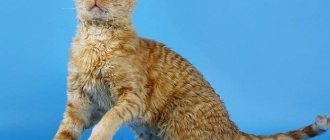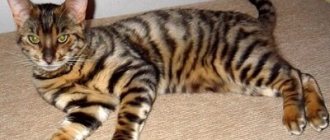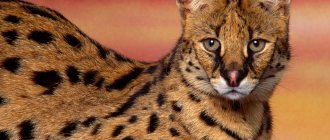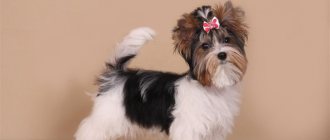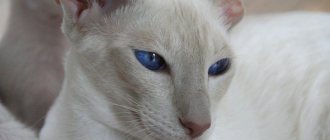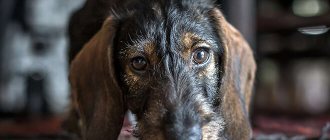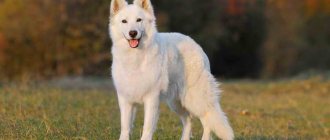History of the origin of pixiebobs
There is still controversy about the origin of pixie bobs. There are beliefs and legends about them. Some are convinced that this unusual cat is the fruit of love between an ordinary cat and a beautiful lynx, although this is unlikely. The version that pixiebobs can be classified as cats of American origin is more plausible. This breed is most likely the work of human hands. The immediate ancestor of the breeding of these cats is considered to be the American Carol Ann Brewer.
Interesting fact: The history of the creation of the breed dates back to the 80s of the last century, when Carol adopted an unusual kitten (feline) from farmers. She had a short tail and had more fingers than expected (polydactyly). After some time, the woman acquired a new bobtailed pet cat, which she simply picked up on the street.
Although the cat led a wandering lifestyle, it was quite respectable in size and had a large mass. Carol decided to crossbreed her unusual pets, as a result of which a beautiful short-tailed cat with a spotted coat was born. She was named Pixie, which means "elf". This cat can be considered the founder of the pixie-bob breed, which literally translates as “short-tailed elf.”
The American continued to engage in her breeding activities and soon showed the world the extraordinary felines she had bred, presenting them at a special exhibition in Washington. These mini-lynxes delighted the public and made Carol a real celebrity who managed to make a feline breakthrough. Pixie bobs acquired official status only in 1995, at the same time the standard for this breed was adopted, lynx cats were registered by such famous and honorable associations as ACFA and TICA.
Breed characteristics
Pixie-bob cats are distinguished by their by no means small dimensions. An adult male weighs about 7–9 kg, and females weigh 4–6 kg. They have a strong build with well-developed muscles, a powerful, wide chest. There is a slight fold on the abdomen. The head is quite large, but proportional. It is pear-shaped, whereas a normal cat has a wedge-shaped head. Whiskers on the cheeks make these cats even more lynx-like.
Pixiebobs have a strong build and well-developed muscles
The ears are wide, with a rounded top. The standard allows both the presence of lynx tassels on them and their absence.
The eyes are medium size, deep set. A distinctive feature is the look from under the brows, the so-called wild look. Experts believe that a real pixie-bob must have it. Eye color can be green or golden to brown.
Pixie Bob kittens are born with blue or light blue eyes, which become the breed's characteristic color as they grow older.
The nose of these cats is wide, slightly convex, with a slight hump. The legs are long and strong, the hind legs are longer than the front ones. The fingertips are rounded. Polydactyly is allowed with a maximum number of 7 toes on each paw.
The tail is a characteristic feature of the pixiebob and should be short: from 5 cm to the hock. It allows kinks and bends.
The hock joint is located on the cat's hind legs.
There are both long-haired (hair length about 5 cm) and short-haired (up to 3 cm) representatives of pixiebobs. The coat of both varieties is soft to the touch. Brown, red or gray color with ticking (coloring the hair alternately with dark and light stripes) is allowed. It is necessary to have darker spots and stripes that imitate the color of a lynx. The fur on the belly, chest and inside of the paws is lighter. The paw pads are black or dark brown (dark chocolate shade). The color of the tip of the tail should be the same as the pads. Dark stripes extend from the outer corner of the eyes towards the cheeks, and on the forehead you can see a pattern in the shape of the letter M.
Photo gallery: appearance of pixie bob cats
The so-called “wild look” of pixiebobs is their calling card.
Short-haired pixie-bob cats are more common than long-haired cats.
Long-haired pixie bobs have fur that can reach 5 cm in length.
Pixie-bob kittens have blue or light blue eyes.
There are pixiebobs that are brown, red or gray in color.
Character and behavior
Despite its menacing appearance, the pixie-bob is a very friendly cat. She treats children very well. This cat is characterized by playing without releasing its claws, which prevents scratches on the human body. Pixiebobs require constant attention and do not tolerate prolonged separation from their owner. Representatives of this breed are moderately talkative and rarely speak up.
They treat strangers with caution; they are unlikely to allow themselves to be petted, but they will not attack either. Despite the friendliness of pixiebobs, the presence of another pet in the house often leads to the fact that the furry pet begins to show aggression towards its neighbor due to jealousy of the owner.
Pixiebobs are often called dogs in cats' clothing for their devotion to their owner. Of all the household members, a cat of this breed chooses one whom she is ready to greet at the door and to whom she will show signs of greater favor than everyone else.
These cats are very smart and trainable. The high energy of pixiebobs requires room for freedom of movement. Ideally, this breed should live in a private home to follow its hunting instincts. In an apartment, it is necessary to provide the cat with a sufficient number of toys and often play with it.
Playful pixie-bob needs toys and attention from owner
Health and life expectancy
On average, pixie bob cats live 13–15 years. They are distinguished by good health. No genetic predisposition to certain diseases has been identified at the moment. However, sometimes individuals of this breed react to vaccination with an allergic reaction and suffer from hypertrophic cardiomyopathy (thickening of the wall of the ventricle).
It is necessary to carefully monitor the weight of your furry friend, since its large dimensions are very difficult to distinguish from excess weight.
Pixiebob - description of the breed
Cats of this breed are of medium size, their weight does not exceed five kilograms, and the weight of more respectable and larger cats ranges from 8 to 10 kg. A distinctive feature characteristic of this breed is the pear-shaped head, as well as expressive, slightly sad, eyes.
Interesting fact: Thanks to their massive eyelids, cats always look serious. One of the main extraordinary features is the already mentioned property of polydactyly.
As already mentioned, the animal’s head has a pear-shaped outline, distinguished by the power of its chin and a fairly wide diamond-shaped muzzle, the sides of which are equal and symmetrical. The convexity in the vibrissae area is well expressed and immediately noticeable, and the lynx sideburns, which are mandatory, add a special charm.
Cat ears have average parameters; they are deep-set and widen towards the base. Their ends are slightly rounded, and tassels are very welcome, especially in males. A lighter imprint can be seen on the outside of the ear. The pixie bob's eyes are also of medium size, triangular in shape with smooth, streamlined lines and rather heavy and solid eyelids.
The physique of the pixie-bob is quite powerful and solid, with well-pronounced protruding shoulder blades. The line of the hips is slightly higher than the shoulder line; they themselves (the hips) have an average width and also protrude slightly. The chest is very wide, and there is a layer of fat in the abdominal area.
The limbs of pixiebobs have an elongated structure, with the hind legs being larger than the front ones. The paws are equipped with large toes, the number of which may exceed the usual number of cat toes. In general, having 7 toes is considered a big plus for this breed. A short tail is the calling card of pixiebobs; the shortest is considered to be 5 cm in length. Its length can reach the hock joints, despite the fact that the paws are extended. The presence of bends and creases on the tail is considered desirable.
If we analyze the image of pixiebobs as a whole, then cats of this breed can be called impressive; they have a combination of animal wildness, feline grace and a cozy, homely disposition.
Pixie Bob Health
Cats of this breed are hardy and have strong immunity. They do not inherit any diseases. The relatively natural shape of the tail eliminates the development of diseases such as proctitis or curvature of the spine. Most often, representatives of the breed suffer from obesity. The main reasons for its occurrence:
- sedentary lifestyle;
- uncontrolled and unbalanced nutrition;
- hormonal disorders;
- castration/sterilization.
Obesity in cats is considered to be 20–30% excess weight.
Symptoms:
- severe shortness of breath with little activity;
- the cat becomes fat;
- it is impossible to palpate the ribs and spine through the fat layer;
- the animal practically does not move, eats a lot, and problems with joints appear.
Treatment should be prescribed by a veterinarian after examining the animal. Usually this:
- gradual increase in physical activity;
- drawing up the right diet with a veterinarian;
- taking hormonal drugs.
Popular pixie bob colors
It is worth noting that pixiebobs come in long-haired and short-haired varieties. In the first group, the length of the fur can reach up to five centimeters. Both species have longer fur in the belly area compared to the rest of the body. Let's try to understand the color variations of this unusual cat breed.
Pixie-bob cats are distinguished by varying shades of spotted brown tabby. They may be mouse-colored or have inverted ticking (there is a light rather than dark color at the tips of the hairs). You can often notice a light neck and belly in animals. Shades and tones can change in different seasons of the year and due to the molting process.
They can be:
- Reddish;
- Brown;
- Brown;
- Reddish.
It is worth noting the following features regarding the pattern of a cat’s fur coat:
- The pads on the paws have a rich chocolate tone;
- The cat's eyes are outlined by a border of white or flesh-colored colors; their special beauty is emphasized by the presence of dark stripes going down to the bottom of the muzzle;
- The very tip of the cat's tail should be a dark shade - either completely black or chocolate;
- An ornament resembling the letter “M” is clearly visible above the eyes;
- The snow-white tips of the whisker pads at the very base of the fur have a darkened tint;
- Dark spots decorating the fur coat are located throughout the body and belly.
Catering
The pixie-bob cannot be called picky: he eats everything that is in his bowl with equal appetite, and if the portion seems too small to him, he will, without a twinge of conscience, climb into the trash container to inspect it. The owner should immediately decide what he will feed the cat, since, having become accustomed to one type of food, the animal may have difficulty withstanding its change, and jumping back and forth is harmful for the stomach.
Natural products
If you choose a natural diet, consult your veterinarian: he will create a menu taking into account the physical characteristics of your animal. Portion sizes and composition depend on the age of the cat, its size and the presence of any diseases.
Very young kittens eat more often than adults: up to 3 months - 5-6 times a day, from 3 to 4 - 4 times, from 4 to 6 - 3 times, over six months - 2 -3 times. Animals that are old, emaciated, with chronic diseases, lactating and pregnant cats eat more often and more.
The diet must include:
- Meat and offal. Meat (veal, rabbit, beef, turkey, lamb) is pre-frozen, kept in the freezer for 2-3 days (to destroy pathogens), and before serving, chopped into small pieces and doused with boiling water. You can feed your cat both boiled and stewed meat, but long-term heat treatment destroys some of the nutrients. The same applies to offal. Liver, kidneys, hearts, chicken necks are cut into convenient pieces, stewed a little and given to the cat 2-3 times a week.
- Porridge. Rice, oatmeal, pearl barley, buckwheat, corn, semolina porridges are well nourishing. They are boiled in water (a little milk can be added, just for taste), without sugar, salt or spices, and given to the cat every day or every other day.
- Vegetables. Cats are allowed to eat carrots, zucchini, pumpkin, beets, asparagus, broccoli, and greens (green salad, parsley, dill). Vegetables are finely chopped and boiled or stewed (the cat refuses to eat them raw, but happily gnaws on fresh cucumbers in the garden beds).
- Fish. Fish contains many useful substances, but you should not give it more than once a week: there is a high risk of developing urolithiasis. This disease primarily affects cats. Choose sea fish with a minimum of bones.
- Dairy products. Kefir, fermented baked milk, Varenets, natural yogurt, cottage cheese, yogurt, sour cream, cream, goat milk, hard cheese - all this must be on the menu.
- Fruits. Apples, melons, pears.
- Clean water.
You should choose foods to feed your cat especially carefully: much of what we humans eat, cats cannot eat. If possible, shop at farmers' markets or from private sellers.
It is forbidden to give Pixie Bob:
- Smoked, salty, sweet, pickled, sour, fatty, flour, baked goods.
- Salt and sugar in their pure form, seasonings, spices, ketchups, sauces, mayonnaise.
- Legumes, potatoes, tomatoes, eggplants, peppers, grapes, bananas.
- Carbonated drinks, alcohol, juices, fruit drinks, compotes.
- Fatty or rotten meat, skin, bones.
- Products with dyes and chemical additives.
- Food for dogs or other animals, human vitamins.
Recommended food
Breeders advise feeding your pixie bob natural food, but if you like industrial food, buy only holistic or super-premium food. These foods are considered to be of the highest quality and healthiest, while economy and premium cat foods do not demonstrate the declared qualities, and their compositions “leave much to be desired.”
High-quality holistic food: PureLuxe, Savarra, Wildcat. Super premium food: Pronature Life, Sanabelle.
Below are the recommended holistic and super-premium foods. Links with the names of the food are clickable, on them you can, within our website, get acquainted with the descriptions of the food and read reviews from owners of Pixiebob cats.
| Holistic | Super premium | Super premium |
| Wellness CORE | Naturea | Vigor & Sage |
Character and habits of pixiebobs
Pixiebobs seem wild only because of their unusual lynx appearance; in reality, they are very friendly and attached to their owner. Many cat owners claim that in behavior, these cats are similar to faithful dogs. Pixies are very smart, intellectually developed, observant, and very trainable. Cats try not to lose sight of their beloved owner and always be nearby. They are characterized by mobility, activity, funny playfulness and a certain mischief, so you won’t be bored with a pixie-bob.
Interesting fact: These whiskered mini-lynxes, like devoted dogs, are always happy to meet their owner and other family members right at the door; they will not hide their delight at the meeting. Cats cannot do without attention and constant communication; they constantly need to devote time, it is worth taking this into account if you are planning to get such a pet.
On the other hand, it is worth noting that pixiebobs are not noisy; they will not meow without a reason and will not force their communication. It is advisable to provide Pixiebob with a variety of toys so that he does not “play” with some of the things he likes that belong to the owner or other household members.
It must be added that pixies are very jealous, they do not want to share their owner with anyone, so they will not tolerate other pets on their territory. According to these cats, all human attention should belong exclusively to them. These bobtailed pets do not show much trust towards strangers, they behave warily and most often try to hide and not make contact at all, waiting in a secluded place for the strangers to leave.
Pixie-cats can confidently be called conservatives; they gravitate towards stability and an established life, with difficulty enduring even small life changes. If the owners have to be away for a long time, then experts recommend leaving the pixie-bobs at home, without placing them in specialized hotels or leaving them with relatives.
It's best for cats to stay in familiar and familiar surroundings, so it's a good idea to have someone come over for feeding and cleaning.
Health
The breed is distinguished by good health indicators among its representatives. True, cats do not live long by cat standards - about 13 years.
Pixie-bob is not the most common breed due to its breeding habits. They try to breed a cat no more than once a year. There are few kittens in the litter, no more than three. Survival rate is high. It is significant that kittens become adults by the age of three, not earlier. However, they can be adopted into a family at the age of 12-16 weeks.
In the nursery, kittens are seriously prepared for adult life: Pixiebob is taught the necessary social skills and, of course, is fully vaccinated.
Subsequently, the owner’s task is to prevent mistakes in feeding and keeping Pixiebob. In addition, it is recommended to show the cat to the veterinarian regularly - two to three times a year.
According to reviews, Pixiebob almost never experiences colds or hypothermia. However, due to unbalanced food, the kidneys may suffer or heart problems may develop from lack of attention and love. Affectionate and devoted cats react very sharply to how they are treated: by paying them enough attention, you can celebrate Pixiebob’s 15th and even 17th birthday together.
Interesting facts about pixiebobs
The Pixie Bob is a very unusual and interesting cat breed, about which there are many interesting facts that are worth knowing for those who are planning to get just such a pet.
Let's try to understand them and list the most amazing ones:
- Few people know, but difficult breeding work to develop the Pixiebob cat breed continued for several years;
- As you know, all cats have 18 toes on their paws (five on the front paws and four on the back paws). With the Pixie Bob, everything is completely different; this extraordinary cat can have as many as 7 toes on one paw, which is called polydactyly. This phenomenon is characteristic only of these cats, and is highly encouraged by the breed standard;
- Regular cats grow until they are one year old, but not pixiebobs, they continue to grow until they are four years old;
- Newborn pixie bob kittens have blue eyes, but as they approach seven months of age, their color changes to golden, brownish or green;
- Pixies have an interesting habit and because of this they are known as thieves; cats are always ready to steal the owner’s things that they like and hide them in their hiding place, which can be very difficult for the owner to find;
- In the United States, this cat breed is considered a national treasure, so it is very difficult to export pixiebobs outside the continent;
- In the vastness of our country, pixie bobs are considered very rare. There is evidence that in the Russian Federation there are currently only 15 of them;
- The spirit of conservatism is in the pixie's blood; they hate change, expressing their discontent in every possible way. Sometimes this can reach the point of absurdity, because cats may not like the owner’s new hair color, they may also be annoyed by the change of wallpaper in the apartment;
- Those pixiebobs that have perky tufts on their ears are extremely valued, because not all representatives of the breed have this attribute of beauty and are not so common, so the owners of these elves can be called lucky;
- It’s funny, but the name “pixie-bob” refers not only to feline creatures; it is also the name for a rather fashionable, short, women’s haircut.
Pixie bob kittens, price
Due to the difficulty of breeding as a result of reduced fertility, peculiarities of external appearance, as well as low prevalence, the cost of pixie beans is high. On average, a kitten costs 70 thousand rubles or more. The presence of defects reduces the price, but such a representative of the breed is not allowed to participate in championships and receive titles.
A small photo gallery of pixie bobs:
Pros and cons of pixiebobs
Each breed has a lot of advantages and disadvantages, this also applies to pixiebobs. Naturally, for the owners, their adored pet will always be ideal and incomparable, but it is worth looking objectively, from the outside, in order to identify and emphasize both the pros and cons. This is especially important for those who are thinking about purchasing such a bob-tailed cat. Let's start with the positive aspects.
Advantages of pixiebobs:
- Original and charming lynx appearance;
- These cats are very loyal to their owner;
- Some character traits resemble those of a dog and are highly trainable;
- Peace-loving, good-natured, open, not prone to aggression;
- They are not noisy, they will not meow and scream in vain;
- Unpretentious in care and maintenance;
- They shy away from strangers, which is a plus, because people are different, you never know what’s on their minds;
- Playful and cheerful;
- Easy to learn to walk on a leash;
- They are inquisitive and affectionate; biting and scratching are not for them; these actions occur extremely rarely.
Disadvantages of the breed:
- Excessive conservatism, manifested in the smallest details, these cats are very sensitive to any changes, which they simply cannot tolerate;
- They require a lot of attention, because... very sociable with their household, so if people are too busy, this breed will not suit them;
- They are extremely jealous and will never get along with other pets, because all attention should belong exclusively to them;
- They often trade in theft, flirting with the owner’s things they like;
- The disadvantages include their rarity and high cost.
Pixie Bob character
Under the mask of the “lynx” is hidden a reverent character, as if this is not a descendant of forest cats, but a pupil of the royal court! Representatives of the breed bond well with family members, showing the best qualities. Among them are patience, delicacy, calmness. Animals are always ready for active games, but will not get in the way if you are in a bad mood. This feature of the breed pleases those who prefer solitude, but at the same time do not mind a fluffy and affectionate companion.
Pixiebobs are attached to their family, but do not tend to choose favorites. These cats are equally affectionate towards adults and children, and show rare friendliness even towards strangers. However, some animals prefer shelter under the sofa rather than the company of strangers. Take a close look at your pet's behavior and do not try to restrain it if its chubby face expresses a desire to hide in a secluded corner. Study your pet's habits thoroughly, and there will be no problems with him.
Representatives of the breed are friendly to children, especially the smallest ones, but will not tolerate disrespectful treatment. If a child shows excessive interest in an animal and gets to know it through suffocating hugs and tail tugging, keep communication to a minimum. Pixiebobs rarely show aggression, but are able to stand up for themselves. Otherwise, they are playful and moderately active animals. They often amuse others with their antics and will not refuse a fun game of catch-up.
Although cats are quite calm and friendly, they will show other pets who is boss. Pixiebobs are not the first to start a conflict, but a familiar attitude is still not for them. This breed gets along well with both its relatives and dogs. But ornamental birds and rodents are not the best company. Do not forget about hunting instincts, which can result in the loss of a furry or feathered friend.
Pixiebobs are especially popular among dog lovers, as their behavior is so reminiscent of playful corgis, papillons and Jack Russell terriers. In addition, cats show remarkable training abilities; they love to fetch toys and follow commands. Representatives of the breed are quite silent, “communicate” with the owner using a variety of sounds and rarely meow. Animals become very attached to their owner and cannot stand long separations. If you often go on business trips, consider another breed: Persian, Javanese or Russian Blue. These cats perceive loneliness more easily.
Pixie bobs are not suitable for homebodies either. Animals inherited from their wild ancestors uncontrollable activity and desire to hunt. So you will have to walk your pet on a leash as often as possible and encourage his desire to catch the most beautiful butterfly in the park!
Pixie Bob Breeding
Breeding pixiebobs is a very difficult task; a number of reasons make this activity difficult. The main factor here is the important character traits of pixies, namely, their extremely negative attitude towards any changes and excessive conservatism in everything. Changing places is very traumatic for these cats; it often interferes with participation in all kinds of exhibitions. Peaceful and good-natured at home, pixies can become very anxious and aggressive when in unfamiliar territory.
If we talk about matings, there are also many difficulties here. Pixiebobs have special genes, so crossing with other breeds is contraindicated for them; they should only cross with each other, which leads to great difficulties when choosing a partner, because pixiebobs are very rare. These cats are mainly bred in the United States and Canada. As already mentioned, pixie beans are a real national treasure here, so it’s not easy to take them out of the continent.
In this regard, purebred pixiebobs are the rarest animals in our country, which is why creating a decent domestic population of these lynx elves is not yet possible. Although some nurseries engaged in breeding piskibobs in Russia already exist, they are all in their infancy and cannot compete with American and Canadian ones. For all these reasons, this bobtail cat breed does not have great fame and popularity in our country and does not arouse unprecedented interest.
It is worth noting that pixie-bobs are unusual cats that mature and are fully formed quite late, so large dimensions do not at all indicate that the cat has already matured and become an adult. Let us remember that pixies grow and develop until they are 4 years old, and their entire cat life span is about 13 years.
Care instructions
Wool
The pixie bob's fur is not prone to matting (even in long-haired individuals). Therefore, buy a regular brush with natural soft bristles for grooming and brush your pet 2 times a month. But during the molting period you will have to do this more often - once a week.
Bathing
Pixiebobs love to swim and are happy to get into the bath, but frequent bathing leads to damage to the protective layer on the skin and frequent dermatitis. Therefore, carry out the procedure no more than 6-7 times a year. The exception, of course, is if your pet gets very dirty during a walk or if he has to take part in an exhibition.
You cannot use human cosmetics: they wash away the protective layer from the skin and provoke allergic reactions. Choose only special ones: Rolf Club, API-SAN VELVET CARE, 8 in 1 Perfect Coat Shed Control and Hairball Shampoo, Lugovoi. There are also dry shampoos that are convenient to take with you on a trip, for example, Bio Groom Klean Kitty Waterless.
Claws
Pixie bobs can sharpen their claws on their own, so you are required to purchase a stable and high-quality scratching post. The cat will quickly get used to it.
Ears and teeth
Pixiebobs need to clean their ears once a week, just like brushing their teeth. But if in the first case it is enough for you to have a damp cotton swab on hand, then for the second you will need a little more: a special toothbrush and cat paste. Both can be purchased at a pet store. Companies producing dental care products: Hartz, Trixie, Beaphar Toothpaste. You can buy a toothbrush with a handle, like a child’s one, or in the form of a fingertip.
If your pet categorically refuses to participate in cleaning, you have another option: drip cleansing gel into his drinking water, give him pads to massage his gums from time to time, and take your pet to the clinic for ultrasonic teeth cleaning.
But the latter procedure is not cheap; in addition, it requires preliminary tests and consultation with doctors, so try to accustom the animal to a brush and toothpaste from an early age.
You cannot brush your cat's teeth with human toothpaste! Cats do not know how to spit it out, but only swallow it. This can lead to serious poisoning.
The pixie-bob learns to go to the toilet in the litter box immediately and rarely causes any inconvenience to the owner. But train yourself to clean up after him on time, because a clean pixie-bob is unlikely to want to get into a smelly and dirty container. Choose fillers with large granules (small ones will get stuck between the fingers of a large pixie-bob and cause discomfort).
Pixie Bob Care
As already mentioned, pixie bobs are unpretentious in care, and these pixie bobs are not particularly fastidious. Their main trump card in this regard is unpretentiousness, which is why they require ordinary care, just like a simple, mongrel, domestic cat. It is welcome to allocate a personal place where the pixie can rest; it can be a bed, a special house or an entire structure, if space in the house allows. The cat should have a scratching post so that he can polish his claws. Often the owners of pixie bobs get a leash or harness, because cats have a positive attitude towards such walking.
However, a number of hygiene procedures are necessary for the short-tailed elf. Let's try to figure them out. Experts advise brushing wool weekly, performing this procedure once using a brush with natural bristles. When a cat sheds, brushing needs to be done more often.
Interesting fact: Surprisingly, pixiebobs love water treatments, so bathing will not be a problem. Frequent washing is not recommended for these cats; it should be done once every 3 or 4 weeks so as not to damage the protective skin layer. For bathing, it is better to use special detergent compositions sold in veterinary pharmacies and pet stores.
Pixiebobs need to clean their ears with a cotton pad moistened with ordinary boiled water or a special antiseptic. In general, cat ears require regular examination in order to avoid all sorts of problems. It is better not to use cotton swabs for ear procedures, so as not to damage your pet’s ear canal.
Trimming the pixie's claws is necessary so that the cat feels comfortable when walking. This manipulation is carried out with a special nail clipper. Of course, we shouldn’t forget about long walks, which mini-lynxes adore, which is why they like to spend long periods of time in the fresh air.
History of the Pixiebob breed
The origin of short-tailed cats has given rise to more than one intriguing theory.
The most popular one attributed kinship with wild lynxes to pixiebobs. In fact, the breed appeared completely by accident, but not without the intervention of breeder Carol Ann Brewer. In the 20th century, breeders wanted to breed cats that would become smaller copies of red lynxes, the indigenous inhabitants of North America. The genotypes of outbred domestic cats and short-tailed forest cats were used as material. The development of such a breed in natural conditions was impossible: males in the first and second generations were most often born sterile. Nevertheless, the territory of the United States and Canada was inhabited by hundreds of such hybrids, among which there were also curious specimens.
Miss Brewer became the owner of one of them. In 1985, a woman was vacationing in the west of the continent, at the foot of the Rocky Mountains. As a souvenir, she brought a kitten bought from a married couple. They claimed that the furry baby was the result of the union of an ordinary cat and a wild short-tailed cat. A year later in January, the breeder adopted another pet. It turned out to be a large cat with a short but large tail. The weight of the animal reached 8 kg, despite its exhaustion, and the top of its head was at knee level. The woman gave him the nickname Keba.
In April of the same year, the short-tailed Don Juan became a father: the cat Maggie acquired spotted offspring. Carol Brewer kept one baby and gave her the nickname Pixie. The American breeder realized that she could recreate a new breed with a specific appearance, and began developing a breeding program. Its participants included 23 short-tailed cats captured in the Rocky Mountains region, and the beautiful Pixie. To indirectly refer to their offspring, Brewer coined the term “legendary cat” and registered copyright for the program. Carol's developments were joined by other American breeders who worked with wild cats to create an extensive genetic base and, as a result, the development of the future breed.
The first pixie bob standard appeared in 1989. The breed owes its name to Brewer's favorite. Four years later, the breeder submitted an application to the International Cat Association (TICA), wanting to achieve official recognition of the breed. In 1994 it was registered as experimental. A year later, pixiebobs were included in a number of new breeds and thereby provided the opportunity to participate in championships and exhibitions along with other cats. A handsome short-tailed man named Zeus was even awarded an international prize.
Although TICA representatives included pixiebobs in the official registry, these cats were not recognized by all felinological associations. The main reasons for refusal are the presence of wild ancestors and a past uncontrolled breeding program. According to experts, these factors may negatively affect the further development of pixiebobs.
Despite the skepticism of felinological organizations, representatives of the breed continue to be of interest to both breeders and cat lovers. Unfortunately, the pixiebobs never managed to conquer the entire globe. American breeders consider the breed a national treasure and diligently prevent the export of animals from the continent. For this reason, domesticated “lynxes” are extremely rare in European countries.
Pixie Bob Diet
Pixiebobs can be called omnivores; they are not picky in their taste preferences. The main thing for the owner is to decide what kind of food to give the animal, dry or home-made. The first option is more trouble-free, you just need to choose the optimal composition, paying attention to the presence of vitamins and the balance of all mineral elements. For those who are not looking for easy ways and have enough free time, the second option is perfect, especially since the owner will know exactly what he is feeding his cat.
Young kittens are fed six times a day, gradually reducing the number of meals. Adult cats need only two meals a day (morning and evening). Pixies simply love meat, even for small kittens it is recommended, only lean and preferably chicken. It is better to mix pieces of raw meat, scalded with boiling water, into cereal porridges.
In addition to meat porridges, pixie bobs must have the following products in their weekly menu:
- Eggs (both chicken and quail);
- Low-fat ocean or sea fish;
- Fermented milk products in the form of natural yogurt, cottage cheese, low-fat kefir. All these products must not contain sugars, dyes or any additives;
- Seafood.
It is worth noting that feeding mature cats whole cow's milk is not recommended, as this can lead to digestive problems. If you prefer to feed your pet natural food, then you need to include specialized vitamin and mineral complexes in its diet.
Such supplements are very important during the period of active growth, which lasts for 4 years in miniature lynxes. It is possible and beneficial to include fresh herbs in the cat’s menu, which, when chopped, can be conveniently added to porridges and other main dishes. The mustachioed pets will not refuse bread and crackers either; sometimes they need to be treated to them.
Care and maintenance
The first thing that free lynx elves need is long walks, that is, sufficient movement and fresh air. This is the first thing owners of pixiebobs should think about. After all, for the healthy development of pets, you can’t just take them outside for five to ten minutes and calm down.
The call of wild ancestors, despite the innate intelligence, still makes itself felt. Therefore, from the very first days of a special cat’s stay in the house, the owner needs to devote a lot of time to its upbringing, accustoming it to the rules of the house and its requirements. But the health of pixiebobs and their immunity, as a rule, do not cause concern.
Such animals are not afraid of the cold and feel great at any time of the year. A pet's claws can become a big problem for the owner, as they can ruin carpets and furniture in the house. Therefore, for a pixie-bob, cutting them is very desirable. True, you can protect yourself from these worries by accustoming your pet to a scratching post in early childhood.
The next necessary element of care is weekly combing of the coat. This helps not only to maintain a pleasant appearance, but also prevents unwanted large amounts of hair from entering the animal’s esophagus.
Brushing your teeth, ears, and monthly bathing are also important. The latter usually does not cause big problems. Lynx cats not only love water, but they themselves often want to swim when they see any body of water.
Diseases and health problems
In general, pixiebobs are in good health; no special predispositions to certain types of diseases and no common genetic abnormalities have been found in these animals.
During the time that the breed has officially existed (35 years), there have been isolated cases of problems associated with the reproductive system and the heart (hypertrophic cardiomyopathy or HCM). To determine whether your cat is predisposed to this disease (HCM), you need to know his pedigree. If one of the parents had such a disease, then the animal should have an ultrasound examination every year.
Important fact: Of course, no one is protected from common infections, including pixie-bobs, so scheduled vaccinations and regular deworming procedures are simply necessary for cats. It should be added that pixies can be very sensitive to certain types of vaccinations, so consultation with a veterinarian before the procedures is required.
One of the most important factors in a pet’s health is daily care for it, monitoring its behavior, and proper care. If any suspicious deviations appear in habits and manners, the pixie shows anxiety, is nervous, or vice versa, behaves too sluggishly, then you should definitely go to an appointment with a veterinary clinic to avoid serious negative consequences.
You should also pay special attention to feeding cats and make sure that the diet is balanced; you don’t need to overfeed your cats so as not to develop the problem of excess weight. For mature cats, two meals a day is quite enough.
Character
It is interesting that in terms of behavior and habits, representatives of this breed are more reminiscent of dogs rather than pussies. They are not at all opposed to their owner leading them on a leash during walks, while in a cat’s nature there should seem to be a desire to roam the streets without restrictions.
The fear of water is also not inherent in them, unlike those pussies who are afraid to even get their fur wet. Piskibobs do not exhibit feline selfishness and arrogant detachment; they are devoted to humans like a dog. However, they are also jealous, since they really do not like to share the attention of their patron with anyone else.
But such a desire does not reach the point of militant aggression, for the highlight of their character lies in calmness and restraint. Pussy lynxes, although descendants of wild cats, are not warlike, and therefore get along well with other animals, including the pets of the owner’s house, as well as with his children. The pixie bob cat , despite its inner equanimity, loves to jump, run and frolic.
Although he observes moderation in everything: he plays, but does not play pranks. Showing sociability, she always remembers dignity while keeping her distance. This creature will not tolerate humiliation and injustice towards its own person. Such pussies do not allow themselves to meow loudly, as ordinary cats do, but like dogs they can growl.
These creatures do not like change, and therefore it is better not to transport them from place to place unless necessary. In general, they are domestic in everything, but the free forest nature of the pixie-bob can manifest itself if it is left without attention and care for a long time, because without active contact with people it can become wild. However, reasonable intelligence is also a property of the nature of short-tailed pussies.
Such pets are characterized by good intuition, obedience, and mutual understanding with their patrons. And what’s especially nice is that they easily learn order and follow it. From everything that has been written, it is clear that the character of the pixie bob, with proper upbringing, completely allows the owners to turn the descendant of wild cats into an ideal pet, moreover, gentle and affectionate.
Breeding
The period of pregnancy and childbirth, as a rule, passes by pixiebobs without any difficulties. There are usually 2–3 kittens in a litter. The best age for mating is 2–2.5 years. A pixie bob cat can have up to 3 litters in 2 years.
Typically, cats of this breed give birth to 2–3 kittens.
Mating should be carried out 3–10 days after the start of estrus, which can be determined by the following signs:
- change in appetite (decrease or, less commonly, increase);
- anxiety;
- increased licking of the genitals;
- swelling of the genital loop.
The usual reaction to heat in cats of other breeds, which is expressed by loud meowing, is not common among pixiebobs.
Pregnancy lasts 2 months. It does not imply any special changes in caring for your pet, except for increasing the amount of proteins, fats and vitamins in the diet. Childbirth also usually takes place without complications, but if the owner does not have experience in participating in the delivery of cats, then it is better to contact a professional.
Castration and sterilization
The idea that spaying only applies to male cats and neutering only applies to male cats is false. Castration involves the complete removal of the genital organs of both males and females. Sterilization is the ligation of the seminal canals in cats and the fallopian tubes in cats, which prevents pregnancy, but does not stop the production of sex hormones.
All operations to interfere with the sexual sphere of animals must be done at a favorable time for this, namely, before the onset of puberty, which in pixiebobs occurs at 6–8 months. Most veterinarians recommend sterilization before the onset of the first heat to prevent the behavior pattern that is typical for mature animals during sexual activity from being remembered. Castration can be done later. It is advisable to carry out intervention in the reproductive sphere of a cat before he reaches 1 year of age. Optimally - at eight months of age.
